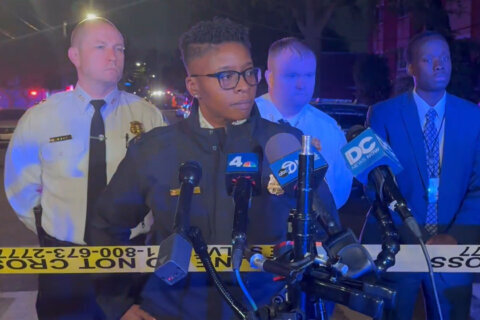WASHINGTON — An area police chief says that while in-car and body cameras are helpful when it comes to documenting interactions with police, they don’t tell the whole story.
Prince George’s County Police Chief Hank Stawinski said at a forum on race and policing at George Washington University Thursday night that “we’re on our third generation of in-car cameras in Prince George’s County, one of the few departments that has full deployment. So we’ve been using this technology successfully for a dozen years, and now we’re enhancing that with the body camera.”
He said that the cameras are a great tool for transparency — “Justice (Louis) Brandeis said sunlight is the best disinfectant” — but that video isn’t enough by itself.
“You’re not going to have the body camera sort of sweep back and capture this entirety of the engagement and understand it fully because of video,” he added. “The video, in collaboration with witness statements, forensic evidence, in collaboration with what we know from trajectory analysis and all of the good forensic sciences — we have a whole bureau for that in Prince George’s County — that’s going to give you a full picture.”
With national attention turned to police-involved shootings of black people, conversations continue on what actions police departments have taken and what civilians can do to help.
Besides cameras, the panelists agreed that more police training is needed.
“Not only should we be getting hundreds of hours on weaponry; you should also have that same amount of hours on de-escalation and cultural competency,” said Danyelle Solomon, director of Progress 2050 at the Center for American Progress.
Stawinski added he is working on making his department more diverse, but it is a struggle. The department is 45 percent African-American, 45 percent white, and the rest are Asian or Hispanic. The chief said it is also about 17 percent female.
But he said he has a plan to recruit more young people to the force.
“What we’re working on is taking some allocated positions in the civilian side of our shop, reallocating them and creating what we’re calling a ‘traffic safety specialist.’ This would be an unarmed, not sworn, representative of the department,” Stawinski said.
He said these employees would perform duties such as directing traffic and writing accident reports, and he hopes to offer them about half the credits for an associate’s degree. Then, when they enter the police academy at age 21, they would earn the other half of the credits through their police training.
Plans aside, when it comes to African-Americans’ distrust of police, Don Cravins, with the National Urban League’s Washington Bureau, said America needs to address the root causes.
“We are not investing in our inner cities. We’re just not. 51 percent of African-American men in the city of New Orleans are unemployed. I’m not blaming the community, and I’m not blaming the police, but if we as a country, we don’t tackle that issue — these are our people,” he said.
“This is America … If you continue what we’ve been doing, which is neglect, and saying ‘Police, you deal with it, and when somebody gets you on tape doing something, we’ll just prosecute you’ — that’s not going to fix it,” Cravins said.
He said he’s heard millennials complain that voting doesn’t do anything, but he said voting is just the start of what citizens should do to bring change, adding, “It’s the accountability after the voting that you’ve got to work on. And if they’re not accountable — you vote them out and you do it. You run.”








